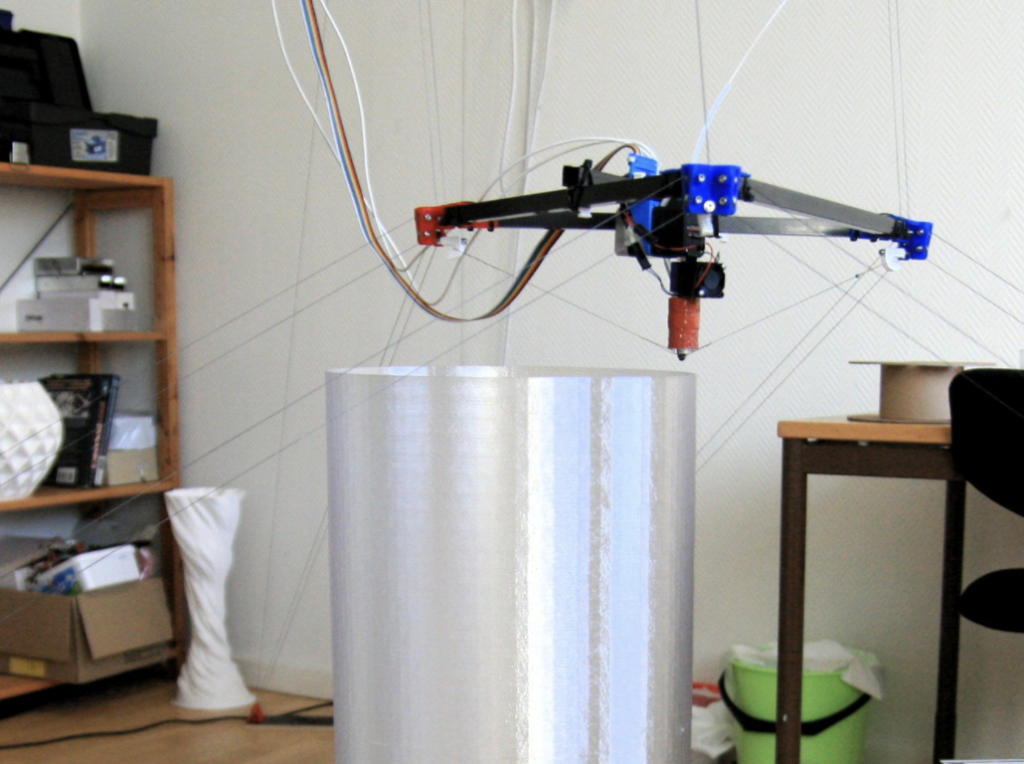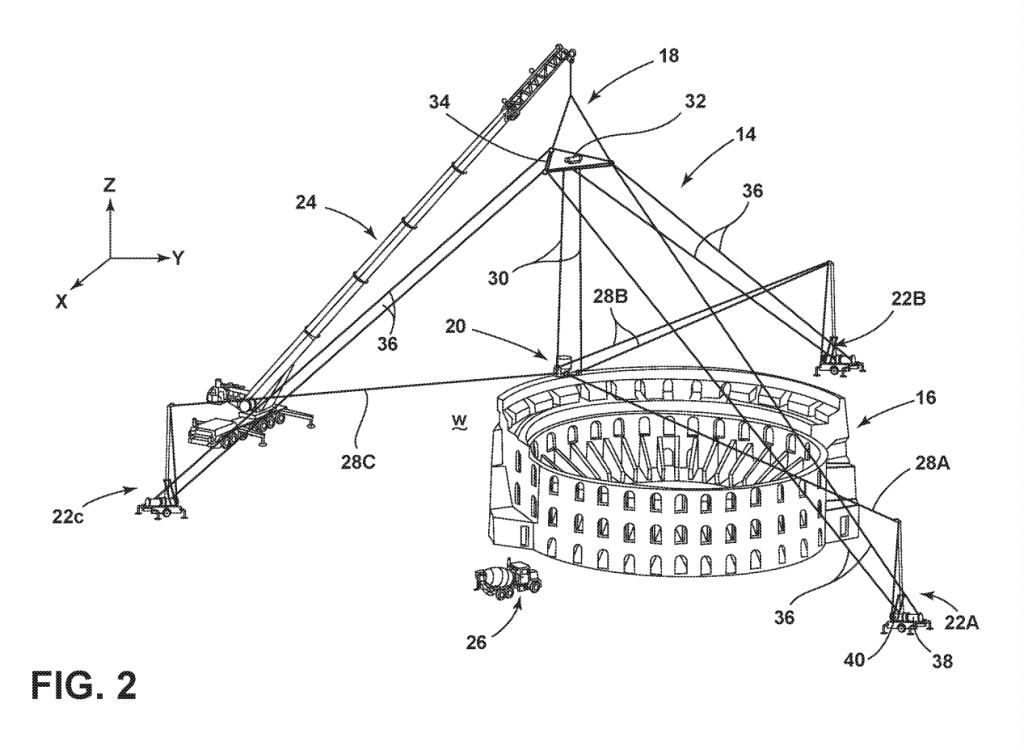Insiders and analysts have made their predictions on the 3D printing trends to watch out for. Find out more in our series focused on the future of 3D printing.
Two of the industry’s leading open-source 3D printing advocates have slammed the award of a patent to researchers at Oak Ridge National Laboratory (ORNL) for their Sky Big Area Additive Manufacturing or ‘SkyBAAM’ technology.
Composed of a nozzle suspended from a series of cords controlled by cable winders, the SkyBAAM system is designed to serve as an alternative to gantry-mounted concrete 3D printers. However, ORNL’s successful patenting of the technology has drawn the ire of Drs. Adrian Bowyer and Joshua Pearce, who highlight its similarity with the now-eight-year-old ceiling-mounted Hangprinter.
“The patent should never have been awarded,” says Pearce. “If you read the patent, the problem they were trying to solve, was how to get rid of the gantry systems for large building-style 3D printing. They did this by copying the open-source Hangprinter concept, only scaling it up and using concrete instead of plastic.”

ORNL’s under-fire patent
Granted last week, ORNL’s SkyBAAM patent outlines the design of a concrete 3D printer that enables a nozzle to be deployed in mid-air, and operated via pulleys connected to multiple on-site base stations. The proposed system requires at least three of these bases to function, with two controlling its end effector’s movements along the X and Y axes, and a third needed to provide tension control.
According to the team behind SkyBAAM, its ease of setup eliminates the need for the time-consuming site preparation required when deploying gantry-mounted systems, which is “preventing them from becoming commercially viable.”
Yet, despite the novelty claims of these ORNL researchers, news of the patent granted to their invention has drawn criticism from the world of open-source 3D printing. In particular, the move has led the likes of Pearce and Bowyer to draw comparisons between SkyBAAM technology, and the Hangprinter system invented by RepRap enthusiast Torbjørn Ludvigsen and highlighted in both a crowdfunding campaign from 2016 and articles from 2017, which could render the patent invalid.
Designed to improve the accessibility of scalable freeform 3D printing, Ludvigsen’s invention features a ceiling-suspended printhead that theoretically overcomes the cost, time, and build volume drawbacks of frame-mounted machines. At the time, the Swede foresaw that in the future, open-source printers would ‘breed’ other more-specialized 3D printers, thus he hoped his creation would “lubricate this process.”
Following news of the ORNL patent’s approval, Bowyer told Ludvigsen on Twitter that his work would likely not be affected, as its validity depended on the technology “not appearing in any prior devices,” a qualification it didn’t appear to meet, while Pearce went a step further, suggesting that the Hangprinter “could be used to invalidate the patent.”
Open-source objections to SkyBAAM
Since his initial exchange with Ludvigsen on Twitter, Bowyer, who not only founded the RepRap Project, but continues to come up with new FFF inventions as a means of preventing them from being locked up in patents, has spoken to 3D Printing Industry, to clarify why he thinks ORNL’s is invalid.
Taking the first 20 numbered claims of the patent as an example, Bowyer says that at least 13 of the SkyBAAM’s features are also present in the Hangprinter, with the others obvious to “a person having ordinary skill in the art” to be replicated in the latter, a key phrase often used in US law to determine whether a patent is invalidated by earlier work.
Bowyer also highlights how the ORNL patent reflects a wider 3D printing trend, in which “trolls are attempting to patent things that are already established in the open-source community,” in a way that “inhibits innovation in every industry.” Likewise, in the case of SkyBAAM, the open-source aficionado says that “none of its claims are novel,” and its features can be seen in the Hangprinter, thus the patent as “invalid.”
Pearce, himself an Academic Engineer at Western University and a serial inventor that developed a sub-$1,000 PEKK 3D printer back in 2020, has weighed in on the debate as well. In his view, “patents are supposed to be for non-obvious inventions,” but he says the tweaks made in SkyBAAM would be obvious to “anyone even remotely familiar with construction and the Hangprinter concept.”
As a result, Pearce explained that he agreed with Bowyer on the actions of so-called ‘patent trolls in the industry,’ and citing an earlier example of someone trying to patent the 3D printing of thermoplastics, he says the ORNL’s move is similar in that it could establish a “20-year monopoly” over the technology that raises a “barrier to rapid innovation.”
“If ORNL’s patent stands now, every construction company that already has access to the core of the equipment will need to negotiate a license to build with it,” argues Pearce. “This case is particularly disturbing if tax dollars from the public were used to develop the patent that is now getting in the way of innovation.”
“I think it is clear tax dollars would be better spent hiring more researchers for ORNLs engineering team and open sourcing the tech rather than paying lawyers to restrict everyone’s freedom to use the technology.”

Could SkyBAAM be challenged?
In order to clarify the validity of ORNL’s patent, 3D Printing Industry also spoke to Maya Eckstein, a Partner at commercial litigation firm Hunton Andrews Kurth and Thomas Prock, a Patent Attorney at Marks & Clerk. Both Prock and Eckstein, in their initial analyses, have highlighted the importance of novelty in the application of the SkyBAAM patent, with the latter saying that ‘prior art’ showcasing similarities would be needed to win any appeal.
For Prock, the fact that the patent’s examiner was only provided with a Wikipedia link about the Hangprinter prior to approving it, may have caused them to misinterpret how deeply its design was similar to that of the Hangprinter. As a caveat, the attorney pointed out that his expertise lies in European rather than US law, he said there could be scope for narrowing the patent’s applicability.
However, although Prock is confident that the US has the legal framework in place for challenging any patents viewed as invalid, he points out that the “costs of such proceedings can be quite high,” something that can prevent cases from being pursued.
In Ludvigsen’s case, the Swede says that he “doesn’t blame the people at ORNL” for attempting to protect their technology, as “grant programs often push otherwise nice people into filing for patents,” but given that SkyBAAM looks like the Hangprinter “sprinkled with a few obvious ideas,” he could well appeal the move, with the aim of keeping cable-driven robotics “as free from patents as possible.”
“I don’t know the difference between a “valid” or “invalid” patent,” concluded Ludvigsen. “I trust Bowyer’s and Pearce’s judgement, but since they’re not lawyers, I’ve asked some lawyers for help too. If the lawyers think the patent is invalid, then I will also think the patent is invalid.”
ORNL, meanwhile, was contacted for comment on the story. At the time of writing, the laboratory’s representatives had not responded.
To stay up to date with the latest 3D printing news, don’t forget to subscribe to the 3D Printing Industry newsletter or follow us on Twitter or liking our page on Facebook.
For a deeper dive into additive manufacturing, you can now subscribe to our Youtube channel, featuring discussion, debriefs, and shots of 3D printing in-action.
Are you looking for a job in the additive manufacturing industry? Visit 3D Printing Jobs for a selection of roles in the industry.
Featured image shows the first iteration of Torbjørn Ludvigsen’s Hangprinter. Image via Torbjørn Ludvigsen.



